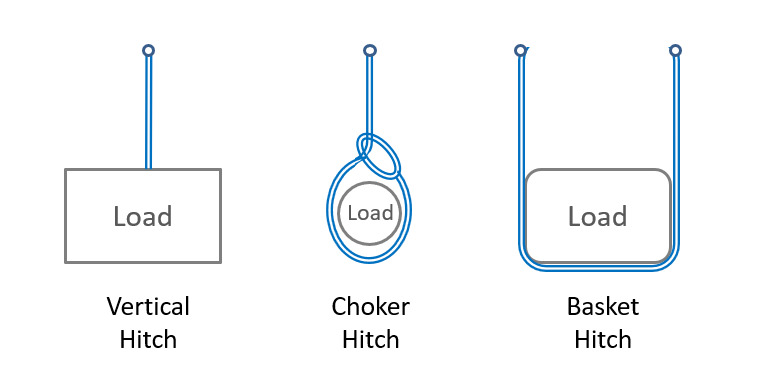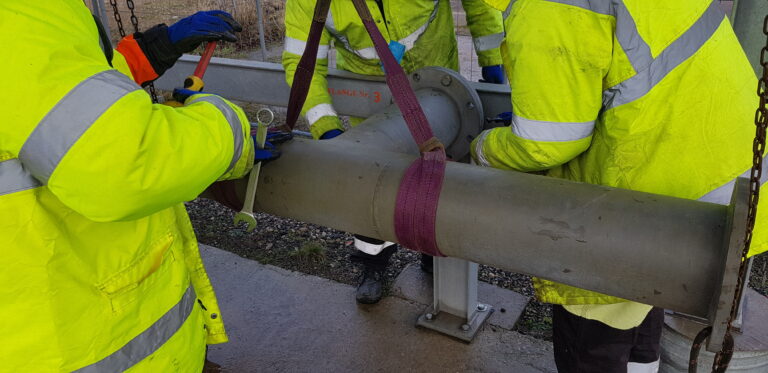Choosing the Right Sling Hitch for Your Lift: Vertical vs. Basket vs. Choker
Choosing the Right Sling Hitch for Your Lift: Vertical vs. Basket vs. Choker
When it comes to lifting heavy loads, selecting the appropriate lifting method is crucial for ensuring the safety of both workers and the cargo. Sling hitches are an essential component of lifting operations, and there are various types to choose from, each with its own strengths and weaknesses. In this blog, we will delve into the three primary types of sling hitches: vertical, basket, and choker, to help you understand which one is best suited for your specific lifting needs.

Vertical Sling Hitch
The vertical sling hitch is one of the simplest and most common methods of lifting loads. In this configuration, the load is lifted vertically using a single sling, with both ends attached to the lifting device. This type of hitch is particularly well-suited for loads that are relatively stable and have a consistent center of gravity. It provides excellent stability during the lift and is straightforward to set up, making it a popular choice for various applications.
Advantages:
Stability: This hitch ensures that the load remains in an upright position during lifting, minimizing the risk of swinging or shifting.Simplicity: This type of hitch is easy to understand and implement, making it suitable for quick lifting operations.
Limitations:
Load Shape: Vertical hitches are not ideal for irregularly shaped or unbalanced loads, as these can cause the load to tilt and potentially become hazardous.Limited Flexibility: Since the load is lifted straight up, the vertical sling hitch may not be suitable for situations where the load needs to be moved horizontally or placed in tight spaces.
…………………………………………………………………………………..
Basket Sling Hitch
The basket sling hitch, also known as the double-leg sling, involves using two slings attached to the lifting device, forming a basket-like configuration under the load. This method is especially effective for lifting loads with irregular shapes or those that require additional stability. By distributing the load’s weight across multiple attachment points, the basket hitch provides enhanced balance and reduces the risk of tipping.
Advantages:
Load Stability: This hitch provides superior stability by cradling the load from multiple points, making it well-suited for loads that lack a consistent center of gravity.Versatility: This method is adaptable to various load shapes and sizes, making it an excellent choice for lifting objects with complex geometries.
Limitations:
Increased Complexity: Setting up a basket sling hitch requires more time and attention to detail compared to a vertical hitch.Clearance: Due to the multiple slings used, the basket configuration may require additional clearance beneath the load, which could be a limitation in confined spaces.
…………………………………………………………………………………..
Choker Sling Hitch
The choker sling hitch involves placing a single sling around the load and then passing one end through a loop or “choker hitch” to create a noose-like configuration. This type of hitch is particularly useful for lifting cylindrical or round objects, such as pipes or tree trunks. The choker hitch grips the load tightly, preventing slippage and allowing for secure lifting.
Advantages:
Secure Grip: This hitch grips the load firmly, reducing the likelihood of slippage during the lift.Load Shape: This method is specifically designed for cylindrical or round loads, making it a necessity for tasks involving such objects.
Limitations:
Load Surface: This hitch may cause abrasion or damage to the load’s surface due to the pressure exerted by the sling.Load Imbalance: If not properly executed, the choker hitch can lead to load tilting or uneven distribution of weight, which can compromise stability.
Choosing the Right Sling Hitch
Selecting the appropriate sling hitch for your lifting operation depends on several factors, including the nature of the load, its shape, weight distribution, and the lifting environment. It’s crucial to assess these factors carefully to ensure a safe and successful lift.
Consider Load Characteristics: If your load has a consistent center of gravity and is stable in shape, a vertical sling hitch may suffice. For irregularly shaped loads, a basket sling hitch could provide the necessary stability. For cylindrical or round objects, opt for a choker sling hitch.

Evaluate Safety: Safety should always be a top priority. Choose a sling hitch that minimizes the risk of load slippage, tipping, or swinging. A basket or choker sling hitch might be more suitable for loads that are prone to such movements.
Assess Lifting Conditions: The lifting environment, available space, and clearance should be considered.
A vertical sling hitch is ideal for confined spaces, while a basket configuration might require more overhead clearance.
Training and Expertise: Ensure that workers involved in the lifting operation are well-trained in setting up and executing the chosen sling hitch correctly. Improper setup can lead to accidents and injuries.
Conclusion
In the world of heavy lifting, selecting the right sling hitch can make all the difference between a successful operation and a potential disaster. Whether you’re dealing with stable, irregular, or cylindrical loads, the vertical, basket, and choker sling hitches each have their unique advantages and limitations. By carefully assessing your lifting needs and load characteristics, you can make an informed decision that prioritizes safety, efficiency, and successful outcomes. Remember, when in doubt, consult with lifting experts or engineers to ensure that you’re choosing the best sling hitch for your specific lift.
——————————————————————————————————————————————
The Hercules Group of Companies encompasses a wide portfolio of products and services across 7 diverse companies.


